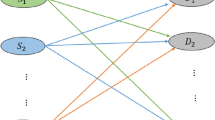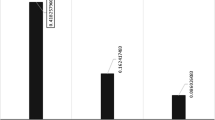Abstract
Neutrosophic sets have been commenced as a generalization of crisp, fuzzy and intuitionistic fuzzy sets to depict vague, incompatible and deficient information about a real world dilemma. Interval-valued fuzzy sets have widely been acknowledged as more proficient in modeling suspicions and practical in assigning an interval of values where allotting an accurate and precise number to an expert’s outlook is too restrictive. They endow with a more appropriate background to characterize higher order of uncertainties and fuzziness of real world. To solve linear programming network problems with constraints concerning interval-valued neutrosophic numbers, a technique has been established by using score function and upper and lower membership functions of interval-valued neutrosophic numbers. An application of energy scheduling problem with constraints represented as interval-valued trapezoidal neutrosophic numbers has been discussed and solved via this technique. Also an additional example to exemplify the proposed method by implementing it on minimum spanning tree and shortest path problem is employed. Furthermore, a comparative examination was performed to validate the effectiveness and usefulness of the projected methodology.


Similar content being viewed by others
References
Alamin A, Mondal SP, Alam S, Ahmadian A, Salahshour S, Salimi M (2020) Solution and Interpretation of Neutrosophic Homogeneous Difference Equation. Symmetry 12:2 1091
Khan N Alam, Razzaq O Abdul, Riaz F, Ahmadian A, Senu N Dynamics of fractional order nonlinear system: A realistic perception with neutrosophic fuzzy number and Allee effect. Journal of Advanced Research, https://doi.org/10.1016/j.jare.2020.11.015.
Artigues C, Lopez P, Hait A (2009) Scheduling under energy constraints, International Conference on Industrial Engineering and Systems Management, Canada, 1-11
Atanassov KT (1986) Intuitionistic fuzzy sets. Fuzzy Set. Syst. 20(1):87–96
Atanassov KT (1989) More on intuitionistic fuzzy sets. Fuzzy Set. Syst. 33:37–46
Atanassov KT, Gargov G (1989) Interval valued intuitionistic fuzzy sets. Fuzzy Set. Syst. 31(3):343–349
Biswas P, Pramanik S, Giri BC (2018) Distance measure based MADM strategy with interval trapezoidal neutrosophic numbers. Neutrc Sets Syst 19(7):40–46
Broumi S, Nagarajan D, Bakali A, Talea M, Smarandache F, Lathamaheswari M (2019) The shortest path problem in interval valued trapezoidal and triangular neutrosophic environment. Complex Intell Syst 5:391–402
Celik E, Gul M, Aydin N, Gumus AT (2015) A comprehensive review of multi-criteria decision making approaches based on interval type-2 fuzzy sets. Knowl Based Syst 85:329–341
Chakraborty A, Mondal S.P, Ahmadian A, Senu N, Alam S, Salahshour S (2018) Different forms of triangular neutrosophic numbers, de-neutrosophication techniques, and their applications. Symmetry 10:327
Chakraborty A, Mondal SP, Alam S, Ahmadian A, Senu N, De D, Salahshour S (2019) Disjunctive representation of triangular bipolar neutrosophic numbers, de-bipolarization technique and application in multi-criteria decision-making problems. Symmetry 11:932
Chen TY (2011) Signed distanced-based TOPSIS method for multiple criteria decision analysis based on generalized interval-valued fuzzy numbers. Int J Inf Tech Decis 10(6):1131–1159
Chen SM, Yang MW, Lee LW, Yang SW (2012) Fuzzy multiple attributes group decision-making based on ranking interval type-2 fuzzy sets. Expert Syst Appl 39(5):5295–5308
Dan S, Kar MB, Majumder S, Roy B, Kar S, Pamucar D (2019) Intuitionistic type-2 fuzzy set. Symmetry 11(6):01–18
Deli I (2018) Operators on single valued trapezoidal neutrosophic numbers and SVTN-group decision making. Neutr Sets Syst 22:131–151
Deli I, Subas Y (2017) A ranking method of single valued neutrosophic numbers and its applications to multi-attribute decision making problems. Int J Mach Learn Cyb 8:1309–1322
Dey A, Pal A, Pal T (2016) Interval type-2 fuzzy set in fuzzy shortest path problem. Mathematics 4(4):01–19
Dubois D, Prade H (1980) Fuzzy sets and systems: theory and applications. Math Sci Eng 144:01–389
Garcia F, Carlos J, Hernandez G (2012) A transportation model with interval type-2 fuzzy demands and supplies. Lect Notes Comput Sci 7389:610–617
Garcia F, Carlos J, Hernandez G (2014) A method for solving linear programming models with interval type-2 fuzzy constraints. Oper Res 34(1):73–89
Garg H, Singh S (2018) A novel triangular interval type-2 intuitionistic fuzzy sets and their aggregation operators. Iran J Fuzzy Syst 15(5):69–93
Sachenbacher M The shortest path problem revisited; optimal routing for electric vehicles, The Technical University of Munich, Department of Informatics, Germany
Jana C, Pal M, Karaaslan F, Wang J (2018) Trapezoidal neutrosophic aggregation operators and its application in multiple attribute decision making process. Department of Applied Mathematics with Oceanology and Computer Programming Vidyasagar University, Midnapore, pp 01–23
Janiak A, Kasperski A (2008) The minimum spanning tree problem with fuzzy costs. Fuzzy Optim Decis Ma 7(2):105–118
Jimenez F, Verdegay JL (1999) Solving fuzzy solid transportation problems by an evolutionary algorithm based parametric approach. Eur J Oper Res 117:485–510
Kahraman C, Onar SC, Oztaysi B (2015) Fuzzy multicriteria decision-making: a literature review. Int J Comput Intell Syst 8(4):637–666
Kundu P, Kar S, Maiti M (2014) Multi-objective solid transportation problems with budget constraint in uncertain environment. Int J Syst Sci 45(8):1668–1682
Kundu P, Majumder S, Kar S, Maiti M (2019) A method to solve linear programming problem with interval type-2 fuzzy parameters. Fuzzy Optim Decis Ma 18:103–130
Lee S, Lee KH (2001) Shortest path problem in a type-2 weighted graph. J Korea Fuzzy Intell Syst Soc 11(6):528–531
Linda O, Manic M (2011) Interval type-2 fuzzy voter design for fault tolerant systems. Inf Sci 181(14):2933–2950
Liu B, Iwamura K (1998) Chance constrained programming with fuzzy parameters. Fuzzy Set Syst 94(2):227–237
Lowgren BH, Weigert J, Esche E, Repke JU (2020) Uncertainty analysis for data-driven chance-constrained optimization. Sustainability 12(6):2450
Maali Y, Amiri NM (2014) A triangular type-2 multi-objective linear programming model and a solution strategy. Inf Sci 279:816–826
Mahapatra GS, Roy TK (2013) Intuitionistic fuzzy number and its arithmetic operation with application on system failure. J Uncertain Syst 7:92–107
Mendel JM (2007) Advances in type-2 fuzzy sets and systems. Inform Sci 177:84–110
Mendel JM, John RB (2002) Type-2 fuzzy sets made simple. IEEE T Fuzzy Syst 10(2):117–127
Mendel JM, John RI, Liu FL (2006) Interval type-2 fuzzy logical systems made simple. IEEE T Fuzzy Syst 14(6):808–821
Own CM (2009) Switching between type-2 fuzzy sets and intuitionistic fuzzy sets; an application in medical diagnosis. Appl Intell 31:283–291
Pramanik S, Mondal K (2015) Interval neutrosophic multiattribute decision-making based on grey relational analysis. Neutr Sets Syst 9:13–22
Qin R, Liu YK, Liu ZQ (2011) Methods of critical value reduction for type-2 fuzzy variables and their applications. J Comput Appl Math 235:1454–1481
Sathya R, Mala R (2017) A new approach for type-2 fuzzy shortest path problem based on statistical beta distribution. Int J Fuzzy Math Archive 14(1):131–137
Singh A, Kumar A, Appadoo SS (2017) Modified approach for optimization of real life transportation problem in neutrosophic environment. Hindawi 01–09
Smarandache F. (1998) A unifying field in logics. Neutrosophy; neutrosophic probability, set and logic. American Research Press, pp 01–157
Smarandache F (2002) Neutrosophy and neutrosophic logic. First international conference on neutrosophy, neutrosophic logic , set, probability and statistics, University of New Mexico, Gallup, USA, 01-147
Smarandache F (2019) Neutrosophic set, a generalisation of the intuitionistic fuzzy sets. J New Theory 29:01–35
Thamaraiselvi A, Santhi R (2016) A new approach for optimization of real life transportation problem in neutrosophic environment. Hindawi 01–09
Touqeer M, Abid H, Misbah A (2020) Multi-attribute decision making using grey relational projection method based on interval type-2 trapezoidal fuzzy numbers. J Intell Fuzzy Syst 38(5):5979–5986
Touqeer M, Kiran S, Rida I (2020) Evaluation model for manufacturing plants with linguistic information in terms of three trapezoidal fuzzy numbers. J Intell Fuzzy Syst 38(5):5969–5978
Touqeer M, Salma J, Rida I (2020) A grey relational projection method for multi attribute decision making based on three trapezoidal fuzzy numbers. J Intell Fuzzy Syst 38(5):5957–5967
Vasant P (2013) Hybrid linear search, genetic algorithms, and simulated annealing for fuzzy non-linear industrial production planning problems. In: Vasant P (ed) Meta-heuristics optimization algorithms in engineering, business, economics, and finance. IGI Global, Hershey, PA, pp 87–109
Wang H, Madiraju P, Zhang Y, Sunderraman R Interval neutrosophic sets, Department of Computer Science, State University Atlanta, Georgia, USA
Wang H, Smarandache F, Sunderraman R, Zhang YQ (2005) Interval neutrosophic sets and logic; theory and applications in computing. Hexis, Arizona
Wang H, Smarandache F, Sunderraman R, Zhang YQ (2010) Single valued neutrosophic sets. Multispace Multistruct 4:410–413
Weaver W (1948) Science and Complexity. Am Sci 36(4):536–544
Ye J (2014) Similarity measures between interval neutrosophic sets and their applications in multicriteria decision-making. J Intell Fuzzy Syst 26:165–172
Yu D (2013) Intuitionistic trapezoidal tuzzy information aggregation methods and their applications to teaching quality evaluation. J Inform Comput Sci 10(6):1861–1869
Zadeh LA (1965) Fuzzy sets. Inf Control 8:338–353
Zadeh LA (1975) The concept of a linguistic variable and its application to approximate reasoning. Inf Sci 8:199–249
Author information
Authors and Affiliations
Corresponding author
Additional information
Publisher's Note
Springer Nature remains neutral with regard to jurisdictional claims in published maps and institutional affiliations.
Rights and permissions
About this article
Cite this article
Touqeer, M., Umer, R., Ahmadian, A. et al. An optimal solution of energy scheduling problem based on chance-constraint programming model using Interval-valued neutrosophic constraints. Optim Eng 22, 2233–2261 (2021). https://doi.org/10.1007/s11081-021-09622-2
Received:
Revised:
Accepted:
Published:
Issue Date:
DOI: https://doi.org/10.1007/s11081-021-09622-2
Keywords
- Interval-valued neutrosophic numbers (IVNNs)
- Interval-valued trapezoidal neutrosophic numbers (IVTrNNs)
- Linear programming problem (LPP)
- Chance-constraint programming (CCP)
- Truth membership function (TMF)
- Indeterminacy membership function (IMF)
- Falsity membership function (FMF)




